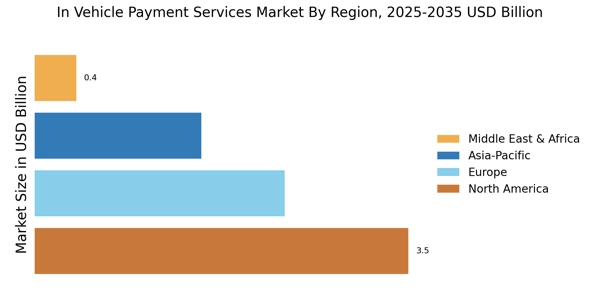Consumer Demand for Convenience
Consumer demand for convenience is a significant driver influencing the In Vehicle Payment Services Market. As lifestyles become increasingly fast-paced, individuals seek solutions that minimize time spent on mundane tasks. In-vehicle payment services offer a streamlined approach to transactions, allowing drivers to pay for services without leaving their vehicles. This trend is reflected in the rising adoption rates of contactless payment methods, which have seen a notable increase in usage. The convenience factor is further amplified by the integration of mobile wallets and digital payment platforms, which cater to the preferences of tech-savvy consumers. Consequently, the In Vehicle Payment Services Market is likely to experience robust growth as it aligns with these evolving consumer expectations.
Integration with Advanced Vehicle Technology
The integration of advanced vehicle technology is a pivotal driver for the In Vehicle Payment Services Market. As vehicles become increasingly equipped with sophisticated infotainment systems and connectivity features, the demand for seamless payment solutions rises. This integration allows drivers to make payments for fuel, tolls, and parking directly from their vehicles, enhancing convenience and efficiency. According to recent data, the market for connected vehicles is projected to reach substantial figures, indicating a growing trend towards in-vehicle payment capabilities. This technological evolution not only streamlines transactions but also aligns with consumer expectations for digital solutions, thereby propelling the In Vehicle Payment Services Market forward.
Expansion of E-commerce and Delivery Services
The expansion of e-commerce and delivery services serves as a crucial driver for the In Vehicle Payment Services Market. As online shopping continues to flourish, the need for efficient payment solutions during delivery becomes paramount. In-vehicle payment services facilitate transactions for goods delivered directly to vehicles, enhancing the overall customer experience. This trend is underscored by the increasing number of partnerships between e-commerce platforms and automotive manufacturers, aimed at integrating payment solutions into vehicles. Market data suggests that the e-commerce sector is projected to grow significantly, which in turn is likely to bolster the demand for innovative payment services within the In Vehicle Payment Services Market.
Regulatory Support for Digital Payment Solutions
Regulatory support for digital payment solutions is emerging as a vital driver for the In Vehicle Payment Services Market. Governments and regulatory bodies are increasingly recognizing the importance of digital payments in enhancing economic efficiency and consumer safety. Initiatives aimed at promoting cashless transactions are likely to encourage the adoption of in-vehicle payment systems. This regulatory environment fosters innovation and investment in payment technologies, which can lead to the development of more secure and user-friendly solutions. As regulations evolve to support digital payment infrastructures, the In Vehicle Payment Services Market is expected to benefit from increased consumer trust and wider acceptance of these services.
Rise of Electric Vehicles and Charging Infrastructure
The rise of electric vehicles (EVs) and the corresponding development of charging infrastructure represent a significant driver for the In Vehicle Payment Services Market. As the adoption of EVs accelerates, the need for integrated payment solutions at charging stations becomes increasingly apparent. In-vehicle payment services can facilitate seamless transactions for charging, thereby enhancing the user experience for EV owners. Market analysis indicates that the EV market is on a growth trajectory, with projections suggesting a substantial increase in the number of electric vehicles on the road. This shift not only supports the expansion of the In Vehicle Payment Services Market but also aligns with broader sustainability goals.


















Leave a Comment